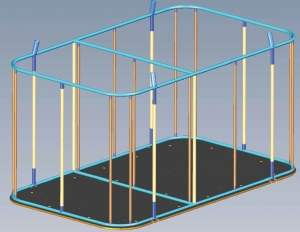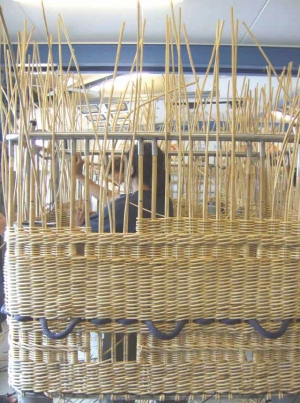
A hot-air balloon basket is generally a very simple unit. Its basic parts are two steel frames - top and bottom - these frames are separated by a number of thick rattan sticks (called manillas) and thinner doubled rattan canes (called stakes). Between these uprights rattan is woven to make a solid but very flexible outer wall and, if required, internal partitions. Two ropes are woven into the side walls to make handles on the outside, so the basket can be lifted, and handles inside so the passengers can hold on.
A waterproof marine plywood floor is attached to the underside of the woven basket side walls and to the underside of this floor are attached solid wooden skids. Along the way stainless steel flying wires will have been been run through the frames and under the basket floor. The top of the almost complete basket is padded and covered in leather; the upright poles fitted to support the burner frame, and the end of the basket wires are swaged. The basket is complete and ready to be fitted out with a cushion floor and side wall padding.
So, why do we use rattan?
 We have been using this classic basket design since we started manufacturing balloons and not just because it looks good and wears well.The main advantage of a wicker basket is its high elasticity. During a landing the impact is absorbed by the wicker as the basket flexes. At the same time, the friction between the various surfaces absorbs energy and converts it to a small amount of heat, not enough to be noticable but sufficient to keep the occupants protected from the impact of landing.
We have been using this classic basket design since we started manufacturing balloons and not just because it looks good and wears well.The main advantage of a wicker basket is its high elasticity. During a landing the impact is absorbed by the wicker as the basket flexes. At the same time, the friction between the various surfaces absorbs energy and converts it to a small amount of heat, not enough to be noticable but sufficient to keep the occupants protected from the impact of landing.
If the basket tips over on a rough landing it is unlikely that the wicker will be damaged. If it is then it will wear naturally and protect the people in the basket. Treated with care a basket does not need any maintenance except for an occasional soaking with water to maintain some moisture in the wicker. Treated with a little care a basket can outlive many envelopes and repay your investment many times over. Some of the first baskets that Kubicek built more than 25 years ago are still airworthy.
Critical basket parts
The major critical items in the basket are the steel cables that run from one karabiner, under the basket, and up the other side of the basket to the karabiner on the other side, crossing each other on the underside of the basket. These wires carry the weight of the basket and all its contents. Other important parts are the skids on the underside of the floor because they spread the weight of the basket and its contents over the entire bottom of the basket. The steel frames do not contibute to the elasticity of the basket but they do help to retain its rigidity.
Both the lower right hand flying wires on the envelope and the lower right hand basket wire are identified by red rubber covers over their swaged ends. Provided these wires are connected together and the other wires attached in the right order then the balloon will have been set up correctly.
Cylinders are held in the basket by cylinder straps, two horizontal straps to each cylinder. Straps from any balloon manufacturer may be used but they must be made from synthetic materials and be undamaged. Home made straps and leather straps may not be used.
Please note: Unlikely the other manufacturers, in our balloons we do not allow to tie the cylinders with leather straps. This is strongly a safety reason when the leather is difficult to untie and loose to take the cylinder out quickly in case of emergency.
Floor area
For the safety of passengers it is important that each person has a floor area of at least 0.25 m2, this minimum floor area, enshrined in EASA’s new regulations, is designed to ensure that everyone has enough space to take up the correct “landing position”.
There is a chart in the Flight Manual which lists the floor area for each size of basket. 0.15 m2 is deducted from this figure for each fuel cylinder and the remaining space is divided by 0.25 to determine how many people can be flown.










 Kamila, assistant
Kamila, assistant Ivo, salesman
Ivo, salesman Martin, salesman
Martin, salesman Milan, salesman
Milan, salesman David, sales manager
David, sales manager Petr
Petr Ondřej, service & after-sales care
Ondřej, service & after-sales care Radim, chief-designer
Radim, chief-designer Radim, executive director
Radim, executive director